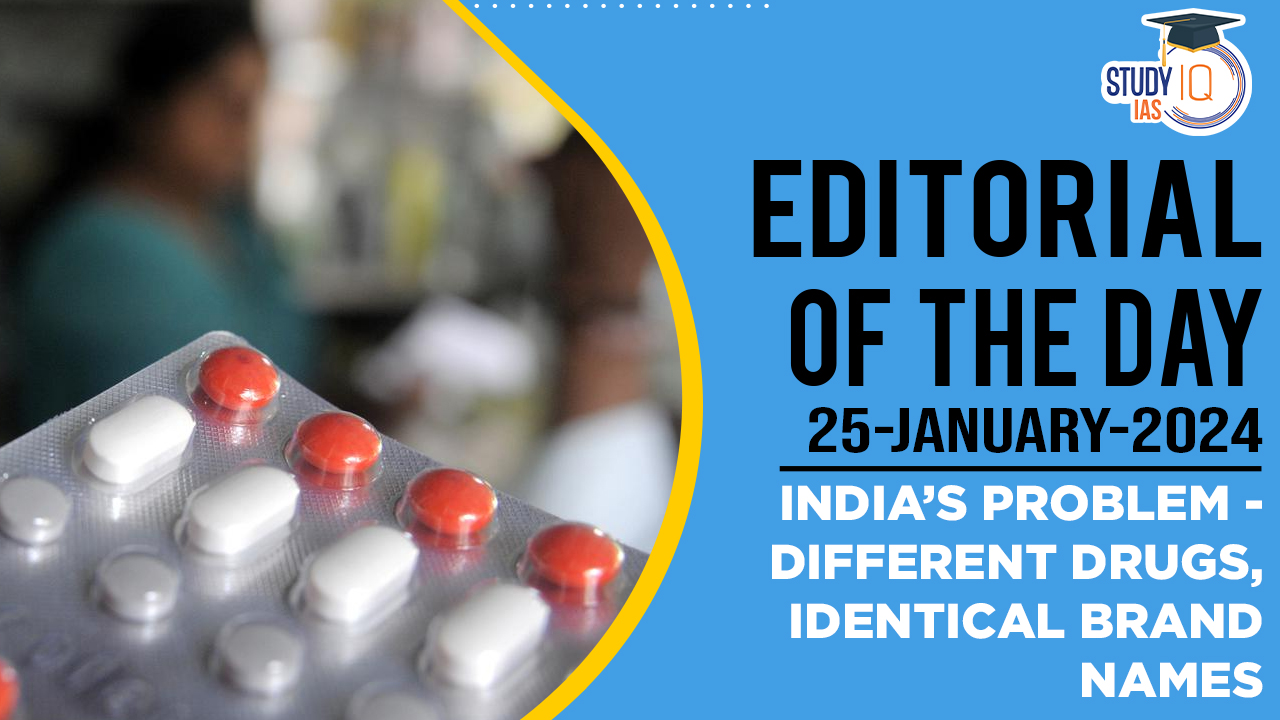Table of Contents
Context: The issue of different drugs having identical or similar brand names in India is a significant problem that poses serious risks to patient safety.
Background
- Different drugs with entirely different active ingredients and uses share identical or confusingly similar brand names in India. This poses a serious risk of patient harm due to medication errors.
- Examples:
- Linamac: ‘Linamac 5’ is used to treat multiple myeloma, which is a type of cancer, the other drug bearing the name ‘Linamac’ is a drug used to treat
- Medzole: Used for a sedative, stomach acidity treatment, deworming, and antifungal medication.
- Medpol, Medrol, Metrozole: Phonetically similar to Medzole, increasing confusion.
- i-Pill and i-Pill Daily: The company that uses the brand name ‘I-Pill’ to sell an emergency contraceptive (ECP), uses the brand name ‘i-Pill Daily’ as a daily contraceptive pill.
We’re now on WhatsApp. Click to Join
Factors Increasing Risk
- Data Deficiency in Prescription Errors: In India, there is an absence of systematic data collection on prescription errors which hinders the understanding of the problem’s magnitude and challenges the development of impactful solutions.
- Regulatory Shortcomings in Pharmacies: A significant number of pharmacies in India distribute medications without the necessary prescriptions and lack stringent regulatory oversight.
- Language Hurdle in Drug Labelling: The majority of drug labels and packaging in India are in English, a language spoken by a minority (under 10%) of the population which adds complexity for numerous patients in correctly understanding medication information.
Judicial Interventions
- Ruling by the Supreme Court of India (2001) And 59th report by the Parliamentary Standing Committee on Health and Family Welfare: The Supreme Court, in the case between Cadila HealthCare Ltd. and Cadila Pharmaceuticals Ltd. and also report by the Parliamentary Standing Committee , highlighted the importance of having unique names for drugs.
- It recommended that the Ministry of Health take steps to avoid the confusion caused by drugs with similar names.
- Intervention by the Delhi High Court (2019): In a notable case involving pharmaceutical trademark infringement, Justice Pratibha M. Singh underscored the critical nature of the issue.
- Her involvement brought heightened attention and urged regulatory authorities to tackle the ongoing problem of drug name confusion more effectively.
- Drugs and Cosmetics (Thirteenth Amendment) Rules, 2019: Companies self-certify non-confusing names during licence applications.
- Required searches for similar names in limited databases.
- Flaws in the Approach:
- Self-certification ineffective (existing name confusion evident).
- No national database of drug names – makes thorough searches impossible.
- Collecting data from 36 diverse drug controllers is a logistical hurdle.
Suggestive Measures
- Build a national database of all pharmaceutical brand names.
- Adopt mechanisms like those in the US and Europe for naming drugs to avoid confusion.
- Establish a dedicated division within the drug regulator to oversee drug names.
- Collect data on prescription errors to quantify the problem.


 Indus Water Treaty 1960 Suspended by Ind...
Indus Water Treaty 1960 Suspended by Ind...
 5 Years of SVAMITVA Scheme and Its Benef...
5 Years of SVAMITVA Scheme and Its Benef...
 Places in News for UPSC 2025 for Prelims...
Places in News for UPSC 2025 for Prelims...





















